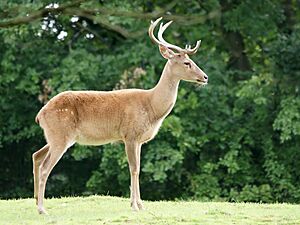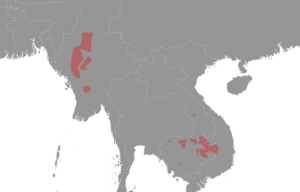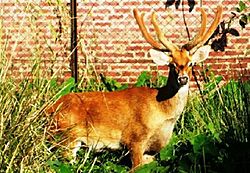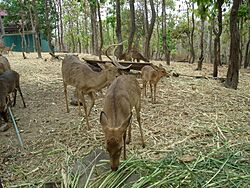Eld's deer facts for kids
Quick facts for kids Eld's deerTemporal range: Middle Pleistocene-Present
|
|
|---|---|
 |
|
| Burmese brow-antlered deer at Chester Zoo | |
| Conservation status | |
| Scientific classification | |
 |
|
| Synonyms | |
|
The Eld's deer (scientific names: Rucervus eldii or Panolia eldii), also known as the thamin or brow-antlered deer, is an endangered type of deer. It lives in parts of South and Southeast Asia.
Contents
About Eld's Deer
What's in a Name?
The Eld's deer was first described in 1840 by John McClelland, a doctor. It was later named after Percy Eld, who described it in more detail in 1841. You might hear it called by different scientific names, like Cervus eldii or Panolia eldii.
Different Types of Eld's Deer
There are three main types, or subspecies, of Eld's deer. They live in different areas:
- R. e. eldii: This type is called the Manipuri brow-antlered deer or sangai. It lives in Manipur, India.
- R. e. thamin: This is the Burmese brow-antlered deer. You can find it in Myanmar and western Thailand.
- R. e. siamensis: This type is the Thai brow-antlered deer. It lives in Cambodia, China, Laos, Thailand, and Vietnam. Some scientists think it might even be a separate species!
How They Look
Eld's deer are medium-sized, similar to the barasingha deer. They have a graceful look with long, thin legs and a long body. Males, called stags, are taller and heavier than females, called hinds or does.
Their fur changes color with the seasons. In summer, it's reddish-brown. In winter, it turns dark brown. Males usually have darker coats than females.
Their Amazing Antlers
The antlers of Eld's deer are very special. They are shaped like a bow or a lyre. Instead of growing straight up, they grow outwards and then curve inwards. A smaller branch grows towards the front of their head. The long, front-pointing parts are called "brow tines." This is why they are called "brow-antlered deer"! They shed their antlers every year. The antlers grow largest during the breeding season.
Size and Weight
Here are some average measurements for Eld's deer:
- Body length (head to tail): 150 to 180 centimeters (59 to 71 inches)
- Shoulder height: 110 to 125 centimeters (43 to 49 inches)
- Tail length: 20 to 30 centimeters (8 to 12 inches)
- Weight: 125 to 175 kilograms (276 to 386 pounds)
- Antler length: Up to 99 centimeters (39 inches)
Saving Eld's Deer
Eld's deer are an endangered species. This means their numbers are very low, and they are at risk of disappearing forever. Many people and groups are working hard to protect them.
In India
In India, the sangai subspecies lives in a special marshland called Keibul Lamjao National Park. This park was created in 1977 just to protect these deer. Local people have learned to care for the sangai. They believe that harming these deer is wrong because they are a link between humans and nature. Efforts are being made to stop people from building on the park land and to prevent illegal hunting.
The number of sangai deer in this park has slowly increased. In 1975, there were only 14 deer. By 2003, there were 180, and by 2004, 182. This shows that protection efforts are working! There's also a successful program at the Alipore Zoological Gardens in Kolkata where they breed Eld's deer in captivity.
In Myanmar
In Myanmar, efforts to protect the thamin subspecies are focused on places like Chatthin Wildlife Sanctuary. Scientists from the Smithsonian Institution have studied the thamin deer here. They learned a lot about the deer's life and how it fits with the environment. For example, they found that the deer's life changes with the seasons. They also learned that deer groups are usually small, often a mother with her young.
The scientists also found that local people depend on the forests where the deer live for wood, food, and medicine. Protecting these forests means finding ways for both people and deer to live together.
In Other Countries
The situation is tougher in places like Thailand, Cambodia, Laos, and Vietnam. In these areas, Eld's deer have been hunted for traditional medicine and for zoos. Their forest homes have also been cut down for farming and buildings. In China, the population on Hainan Island was almost gone in the wild.
However, in the Savannakhet Province of Laos, local communities have helped the deer population grow from 80 to 170. A large sanctuary was even created there just for Eld's deer.
Why They Are Endangered
Over the last 200 years, the number of Eld's deer has dropped a lot. The main reasons for this decline are:
- Hunting: Hunters value their antlers and hides. They are also hunted for food.
- Habitat Loss: Their homes (forests and marshlands) are being destroyed for farming, buildings, and fish farms. In Myanmar, cutting down forests is a big problem for the thamin deer.
- Limited Space: There isn't much protected land left for them. Even in protected areas, illegal hunting can still happen.
- Lack of Funding: Sometimes, there isn't enough money or support to protect these animals and their homes.
- Small, Separated Groups: Because the deer live in small, separated groups, they are at risk of inbreeding. This means they might not have enough variety in their genes to stay healthy.
Deer Life and Habits
Breeding and Young
Female Eld's deer usually live alone or in pairs with their young. But during the mating season, many females and their young gather in herds, sometimes up to 50 deer! Males also live alone, except when it's time to mate. During mating season, males will compete to attract a group of females.
After about 220 to 240 days, a single baby deer, called a calf, is born. The calves have white spots when they are born, which fade as they grow up. They stop drinking their mother's milk at about seven months old and can have their own babies when they are about 18 months old.
Where They Live and What They Eat
Each type of Eld's deer lives in a slightly different place:
- The sangai in India lives in wetlands and marshy areas called phumdis. Their hooves are specially made to move easily in this soft ground.
- The thamin in Burma and Thailand live in different types of forests, not wetlands.
- The siamensis deer in Thailand, Laos, Cambodia, and Vietnam also live in forests, not wetlands.
Eld's deer are active most of the time. They look for shade from the hot midday sun. They might move short distances to find water in the dry season or food when plants are growing. They often look for areas that have been recently burned, because new, tender grasses grow there. Their diet includes many types of grasses, plants, and shoots. They also eat fruits and wetland plants. Sometimes, they even sneak into nearby farms to eat crops like rice, lentils, and maize.
Images for kids
















